Live music offers a unique platform for cultural expression and audience interaction. This article explores the evolution of live music through various genres, examines how audience engagement shapes performances, and highlights the cultural significance of music across different traditions. Additionally, it addresses the challenges faced by live music venues and the role of technology in enhancing the concert experience.
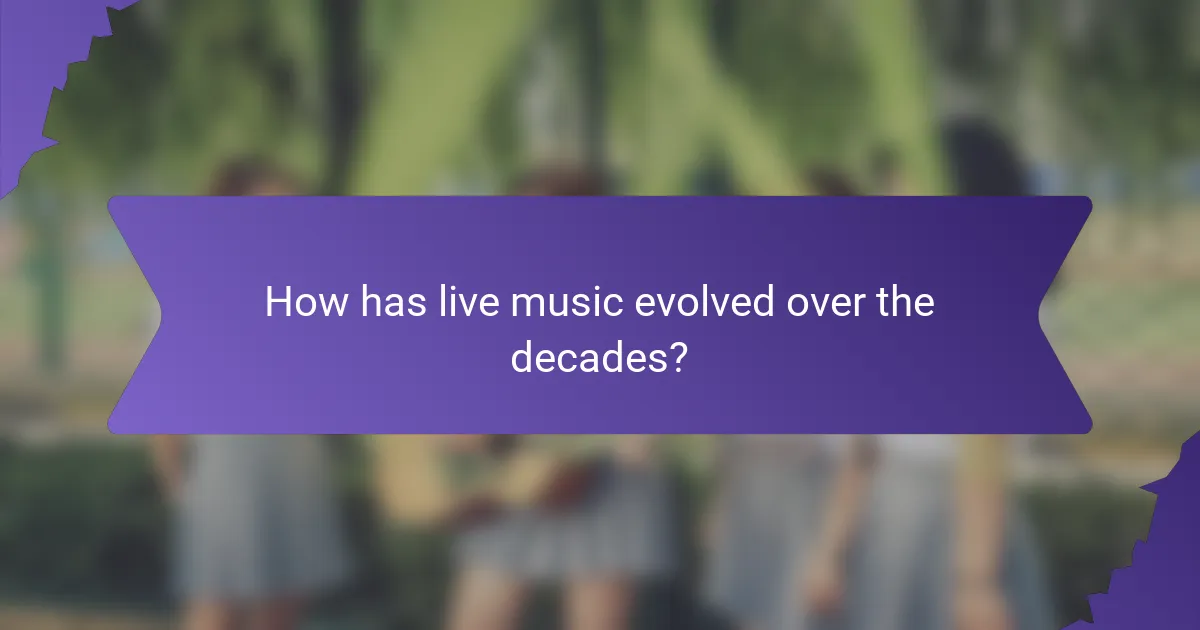
How has live music evolved over the decades?
Live music has transformed significantly over the decades, adapting to cultural shifts and technological advancements. In the 1960s, genres like rock and folk dominated, fostering communal experiences at festivals. The 1970s introduced more diverse genres such as punk and disco, emphasizing individuality and dance culture. The 1980s and 1990s saw the rise of electronic music and hip-hop, influencing audience engagement through interactive performances. Today, live music incorporates technology like streaming and social media, enhancing accessibility and global reach. This evolution reflects changing audience preferences and the industry’s response to new opportunities.
What key technological advancements have influenced live music?
Key technological advancements have significantly transformed live music experiences. Innovations like digital sound mixing, live streaming, and mobile apps enhance audience engagement and accessibility.
Digital sound mixing allows for precise audio control, improving sound quality at events. Live streaming technology enables remote audiences to participate in concerts, expanding reach beyond physical venues. Mobile apps facilitate ticket purchasing, real-time updates, and interactive features, enriching the overall experience.
Additionally, advancements in lighting and visual effects create immersive environments, captivating audiences. These technologies collectively redefine how live music is produced and consumed, fostering deeper connections between artists and fans.
How do cultural shifts impact live music trends?
Cultural shifts significantly influence live music trends by altering audience preferences and engagement methods. For instance, the rise of social media has transformed how artists connect with fans, making live performances more interactive. Genres evolve as cultural narratives change, with diverse influences shaping new sounds. Additionally, societal movements often inspire thematic content in live shows, reflecting contemporary issues. The unique attribute of live music’s adaptability allows it to resonate with changing cultural landscapes, ensuring relevance and audience connection.
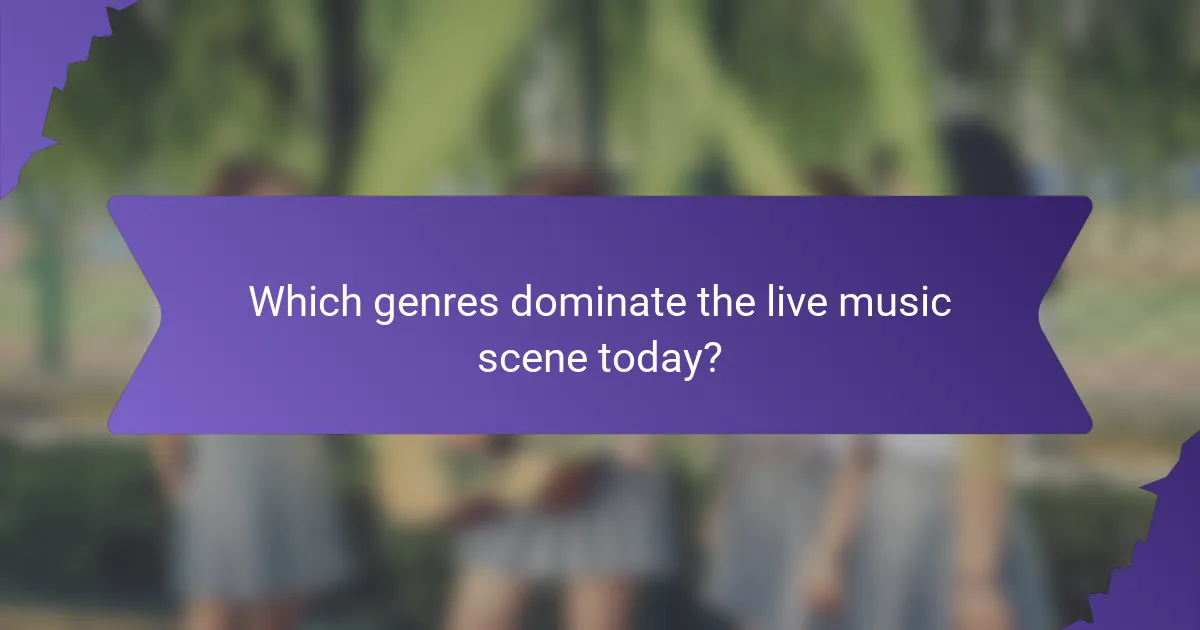
Which genres dominate the live music scene today?
Pop, rock, hip-hop, and electronic genres dominate the live music scene today. Pop remains the most popular, attracting large audiences and mainstream artists. Rock continues to evolve with subgenres, maintaining a loyal fan base. Hip-hop has surged in popularity, often headlining major festivals. Electronic music, with its diverse styles, draws crowds to clubs and festivals alike. Each genre influences audience engagement through unique experiences and interactive performances.
What are the characteristics of popular live music genres?
Popular live music genres exhibit distinct characteristics that engage diverse audiences. Rock is known for its energetic performances and strong instrumentation, while jazz emphasizes improvisation and intricate melodies. Pop music often features catchy hooks and broad appeal, attracting mainstream listeners. Electronic dance music is characterized by its rhythmic beats and use of technology, creating immersive experiences. Country music conveys storytelling and emotional depth, resonating with listeners through relatable themes. Each genre fosters unique audience interactions, enhancing the overall live music experience.
How do regional preferences shape genre popularity?
Regional preferences significantly influence genre popularity in live music. Cultural backgrounds, local traditions, and available venues shape audience tastes and engagement. For instance, folk music thrives in rural areas, while urban centres favour electronic and pop genres.
Demographics also play a crucial role. Younger audiences gravitate towards contemporary genres like hip-hop and indie rock, whereas older generations may prefer classic rock or jazz. Regional festivals further promote specific genres, creating a community around them.
Social media trends can amplify niche genres within certain regions, making them more mainstream. Additionally, local artists often embody regional influences, enhancing relatability and connection with their audience.
Overall, the interplay of cultural, demographic, and social factors creates a dynamic landscape for genre popularity in live music.
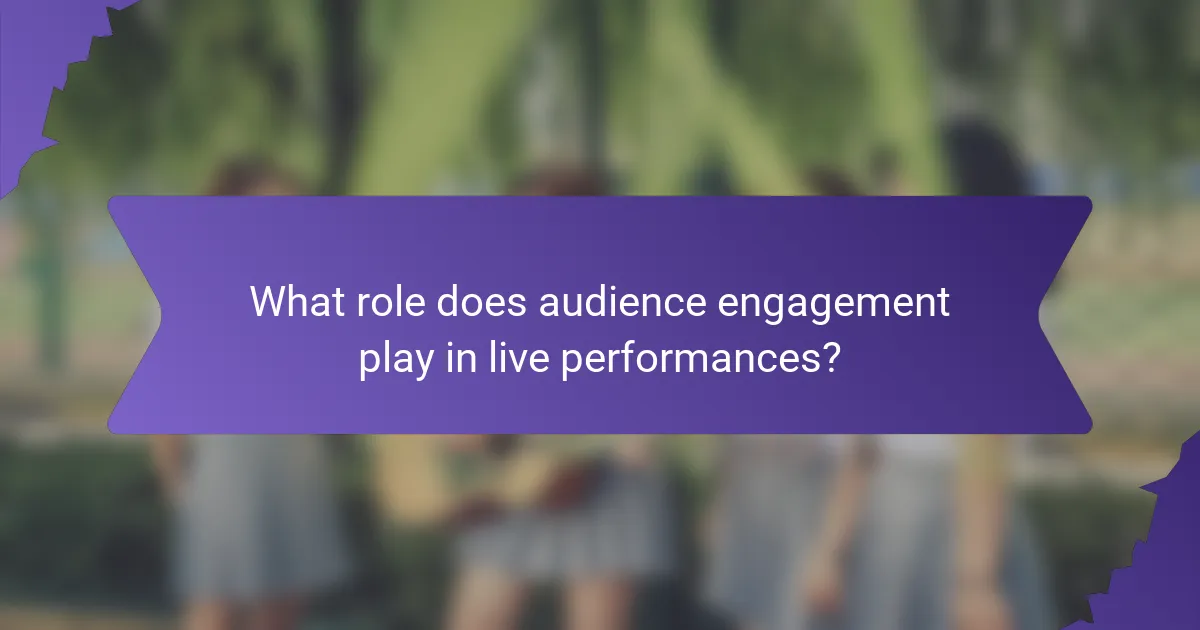
What role does audience engagement play in live performances?
Audience engagement is crucial in live performances as it enhances the overall experience and connection between artists and spectators. Engaged audiences contribute to the atmosphere, influencing the performance’s energy. Artists often adapt their sets based on audience reactions, creating a dynamic interaction. This reciprocal relationship fosters memorable experiences, encouraging fans to return for future shows. Additionally, audience engagement can lead to increased social media sharing, amplifying the reach of performances and boosting artist visibility.
How do artists interact with their audiences during shows?
Artists interact with their audiences during shows through direct engagement, emotional connection, and dynamic performances. They often encourage audience participation, creating a shared experience. This interaction enhances the overall atmosphere, making live music memorable. Unique attributes like spontaneous song choices or personal anecdotes deepen this connection. Engaging visuals and stage presence amplify audience involvement, fostering a lively environment. As a result, the relationship between artists and audiences evolves, enriching the live music experience.
What are the psychological effects of live music on audiences?
Live music significantly enhances audience psychological well-being. It fosters emotional connections, reduces stress, and boosts mood. Studies show that live performances can trigger the release of oxytocin, promoting feelings of trust and bonding among attendees. Additionally, engaging with live music often leads to a sense of community and belonging, enhancing overall life satisfaction.
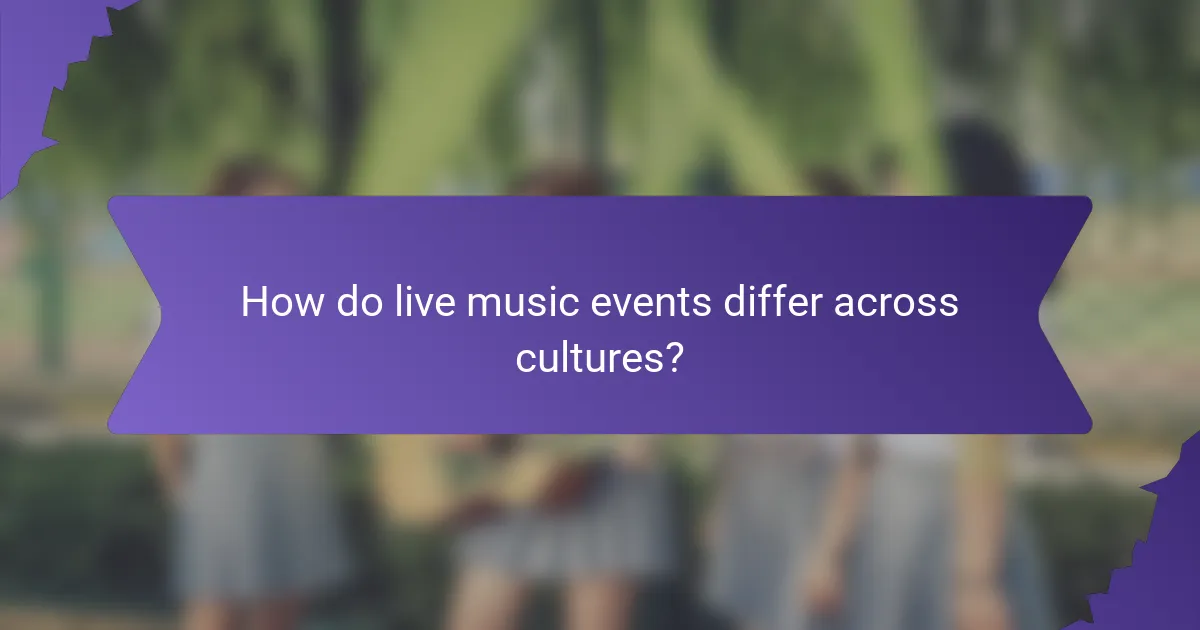
How do live music events differ across cultures?
Live music events vary significantly across cultures due to differing musical traditions, social practices, and audience interactions. In many cultures, live music serves as a communal experience, fostering social bonds. For example, in African cultures, music often accompanies rituals and celebrations, emphasizing community participation. In contrast, Western cultures may prioritize individual performance and concert experiences, focusing on the artist’s expression.
Unique attributes of live music events include the role of traditional instruments in specific cultures, such as the sitar in Indian classical music or the djembe in West African music. These instruments not only define the sound but also the cultural context of the performance.
Moreover, the audience’s engagement can differ; in some cultures, audiences may actively participate by dancing or singing along, while in others, they may adopt a more passive listening role. This engagement reflects the cultural significance of music and its intended purpose, whether for entertainment, ritual, or storytelling.
Overall, cultural differences in live music events highlight the diverse ways communities connect through sound and rhythm, shaping the overall experience.
What unique features define live music experiences in various regions?
Live music experiences vary significantly across regions, influenced by cultural traditions and local preferences. Unique features include distinct genres, venue types, and audience interactions.
For example, in New Orleans, jazz festivals showcase local talent and foster community engagement. In contrast, Berlin emphasizes electronic music with immersive club experiences. Additionally, traditional folk music in regions like Appalachia highlights storytelling and local history, creating a unique atmosphere.
These regional traits enhance the overall live music experience, making it culturally rich and diverse.
How do festivals and concerts vary in format and execution?
Festivals and concerts differ primarily in scale, duration, and audience interaction. Festivals typically feature multiple acts over several days, while concerts focus on a single performance or artist. Audience engagement varies; festivals often encourage socializing and exploration, whereas concerts centre on the performance experience. Unique attributes like venue type and ticketing models also contribute to these differences.
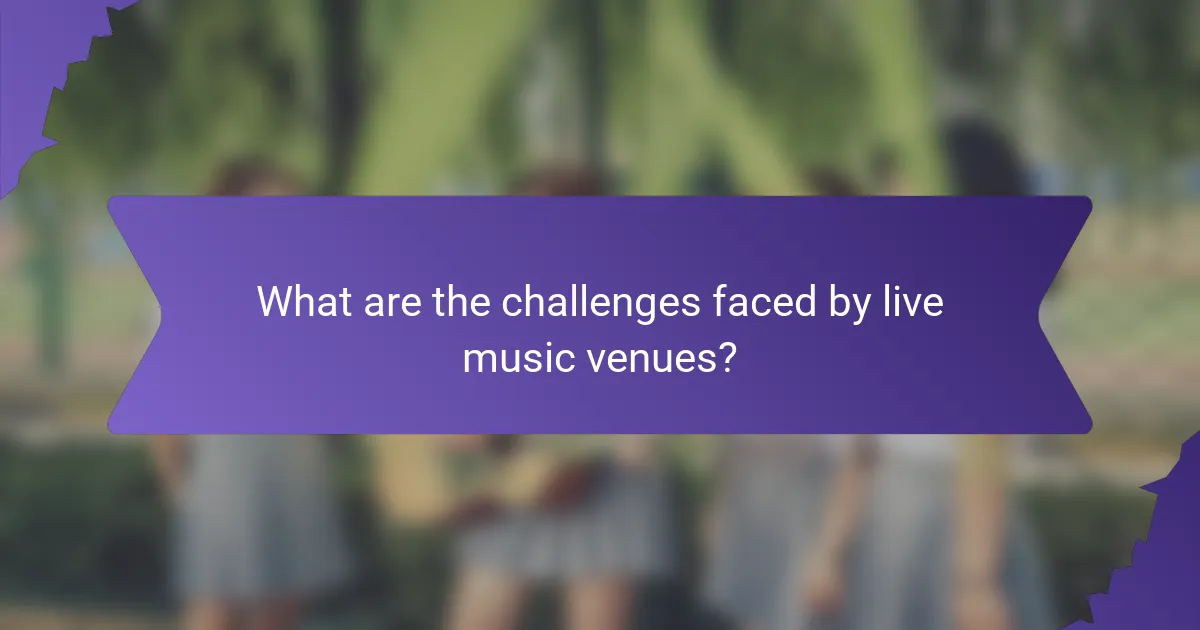
What are the challenges faced by live music venues?
Live music venues face numerous challenges that impact their operations and sustainability. Key issues include financial constraints, competition from digital platforms, and changing audience preferences.
Financially, many venues struggle with rising costs for staffing, equipment, and maintenance. As a result, profit margins can be extremely tight. Competition from streaming services and online performances has shifted audience engagement, making it harder for venues to attract crowds.
Moreover, evolving music genres and trends influence programming decisions. Venues must adapt to diverse tastes while balancing the need for popular acts to drive ticket sales.
Finally, external factors like local regulations and public health concerns can disrupt operations, adding another layer of complexity to managing live music venues.
How do economic factors influence venue operations?
Economic factors significantly influence venue operations by affecting pricing, audience turnout, and overall profitability. Venues must adapt to economic conditions, such as disposable income levels and local market trends, to optimize their performance. For example, during economic downturns, venues may lower ticket prices or offer promotions to attract audiences. Additionally, competition among venues can drive innovation in event offerings and marketing strategies.
Economic indicators like unemployment rates and consumer confidence directly impact audience engagement. Higher unemployment may lead to reduced attendance at live music events, while increased consumer confidence can boost ticket sales. Venues must analyze these trends to make informed operational decisions, ensuring sustainability and growth in a fluctuating economy.
Moreover, the cost of goods and services influences venue expenses. Rising costs for staffing, equipment, and maintenance can squeeze profit margins. Venues often respond by diversifying revenue streams, such as incorporating food and beverage sales or hosting private events. This adaptability is essential for navigating the challenges posed by economic fluctuations.
In summary, economic factors shape venue operations through pricing strategies, audience engagement, and expense management. Understanding these dynamics is crucial for venues to thrive in the competitive live music landscape.
What safety and health considerations impact live events?
Safety and health considerations significantly impact live music events. Key factors include crowd management, sound levels, and venue safety protocols. Effective crowd management prevents accidents and ensures smooth entry and exit. High sound levels can cause hearing damage; therefore, monitoring is essential. Venues must adhere to safety regulations, including fire codes and emergency exits. Additionally, health measures, such as sanitation and first aid availability, are crucial for audience well-being.
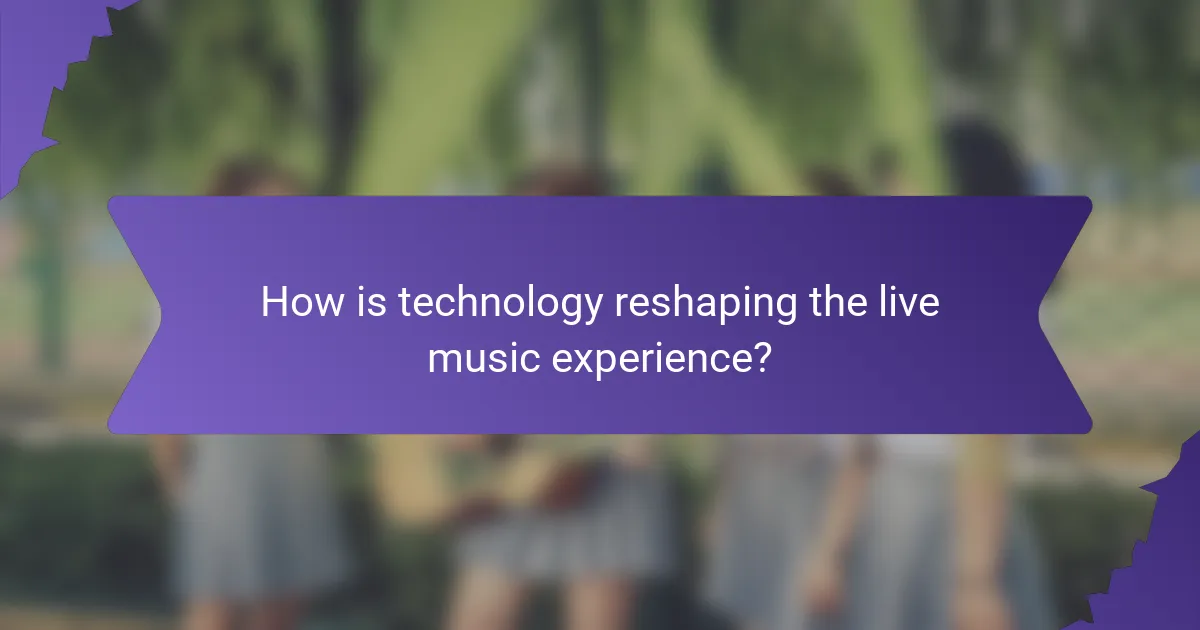
How is technology reshaping the live music experience?
Technology is transforming the live music experience by enhancing audience engagement and accessibility. Innovations like live streaming allow fans to attend concerts remotely, expanding reach. Interactive apps enable real-time fan participation, creating a more immersive environment. Virtual reality offers unique concert experiences, letting users feel present in a digital space. Data analytics help artists understand audience preferences, tailoring performances to enhance satisfaction. These advancements collectively redefine how music is consumed and enjoyed.
What innovations enhance audience participation?
Innovations such as interactive technology, social media integration, and immersive experiences significantly enhance audience participation in live music events. These advancements create a dynamic environment, allowing fans to engage in real-time, share experiences, and influence performances. For instance, mobile apps enable live polling or song requests, fostering a sense of community. Additionally, virtual reality setups offer unique perspectives, making audiences feel more connected to the performance. As a result, these innovations not only enrich the concert experience but also strengthen the bond between artists and their fans.
How do streaming platforms affect live music attendance?
Streaming platforms have a mixed impact on live music attendance, often drawing audiences away from physical venues. Increased accessibility to performances online can reduce the urgency to attend live events. Additionally, platforms like YouTube and Twitch allow artists to reach wider audiences without geographical limitations, potentially diminishing local concert attendance. However, some artists leverage streaming to promote live shows, creating a hybrid model that enhances audience engagement. This dual approach can lead to increased ticket sales for select events, as fans may seek the live experience after enjoying a streamed performance. Overall, while streaming can compete with live music, it also offers new promotional avenues for artists.
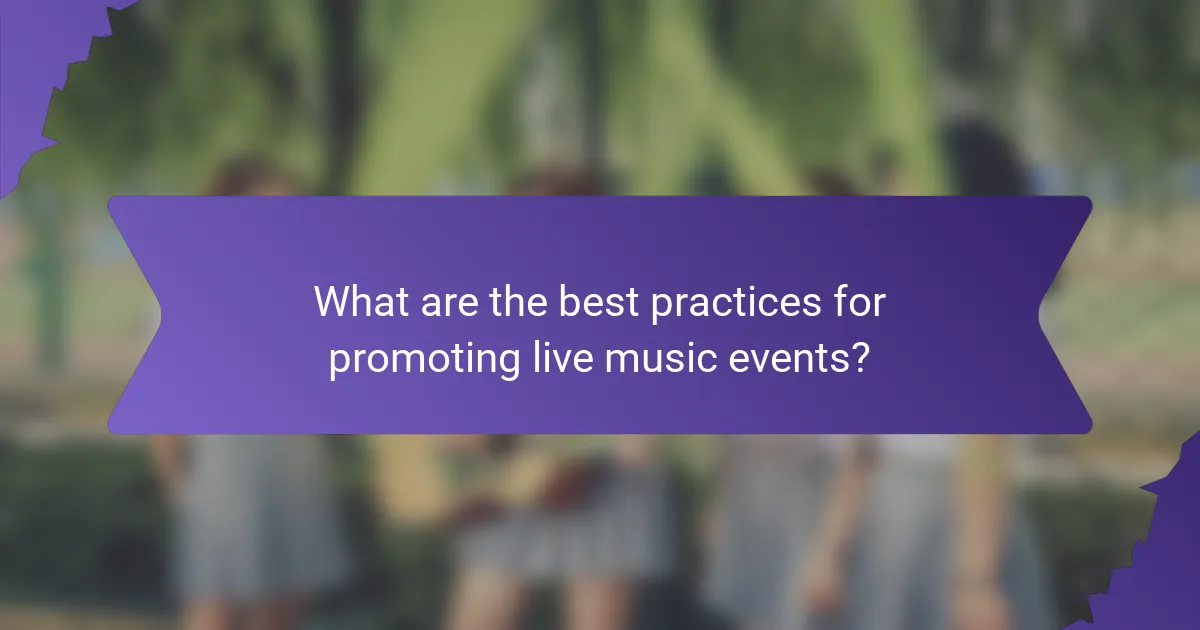
What are the best practices for promoting live music events?
To effectively promote live music events, focus on building a strong online presence, leveraging social media, and engaging with the audience. Utilize platforms like Instagram and Facebook to reach potential attendees and share event details. Collaborate with local influencers to expand your reach and create buzz. Offer early bird tickets or group discounts to incentivize purchases. Implement targeted advertising to attract specific demographics interested in the genre. Engage with the audience through contests or interactive content to foster community and excitement around the event.
How can social media be leveraged for audience engagement?
Social media can enhance audience engagement in live music by fostering real-time interactions. Platforms like Instagram and TikTok allow artists to connect with fans through live streams, behind-the-scenes content, and interactive Q&A sessions.
User-generated content, such as fan videos and posts, amplifies reach and creates community. Analytics tools enable artists to track engagement metrics, helping them tailor content to audience preferences. Collaborations with influencers can further expand visibility and attract new listeners.
Utilizing hashtags and challenges can also encourage participation, creating a sense of belonging among fans. Overall, social media serves as a dynamic tool for building relationships and enhancing the live music experience.
What common mistakes should organizers avoid in live events?
Organizers should avoid common mistakes like poor planning, inadequate promotion, and neglecting audience engagement. Failing to define clear objectives can lead to disorganized events. Not considering the venue’s acoustics may diminish the live music experience. Moreover, overlooking the importance of a diverse lineup can alienate potential attendees. Lastly, ignoring feedback post-event prevents improvement for future occasions.